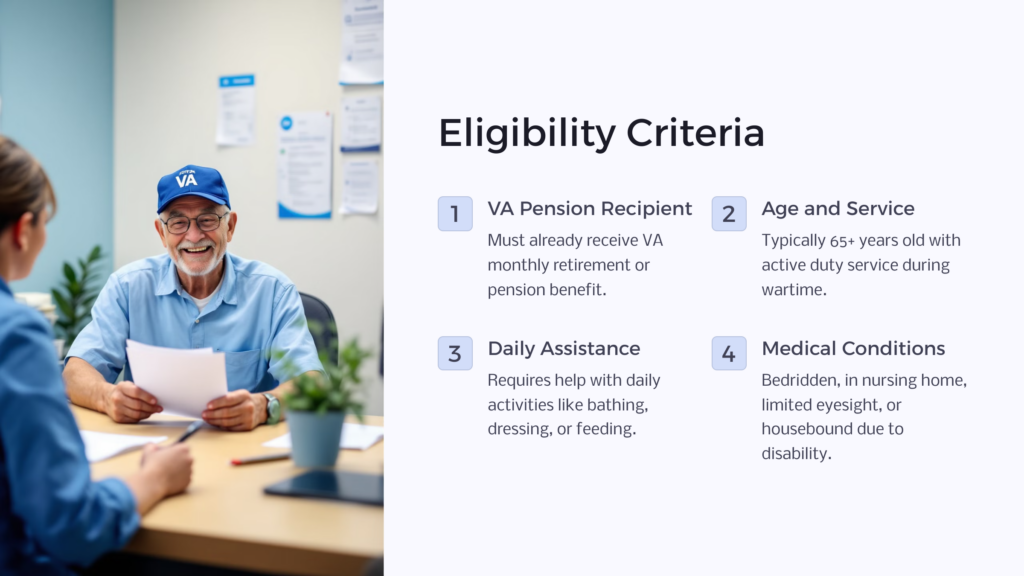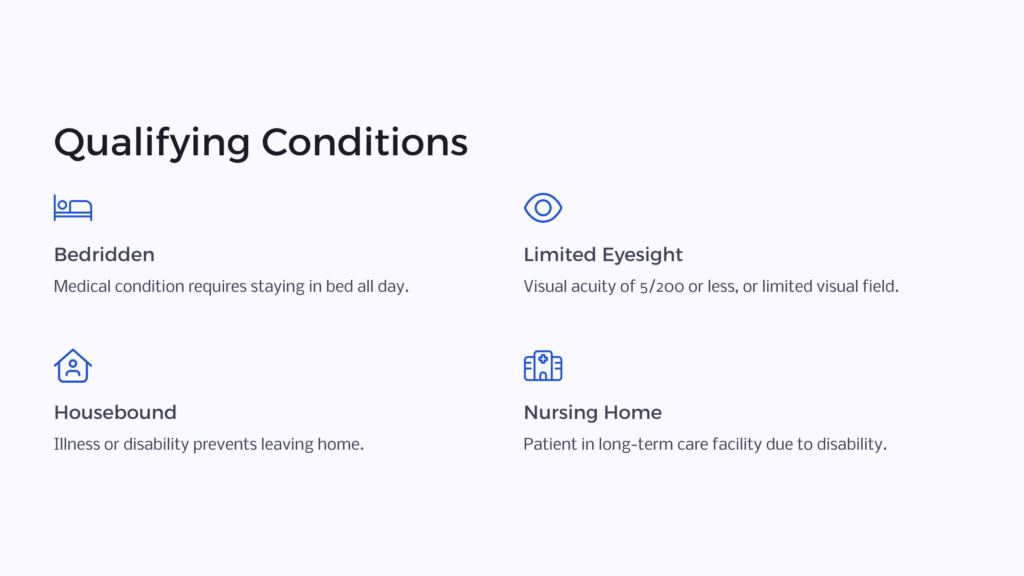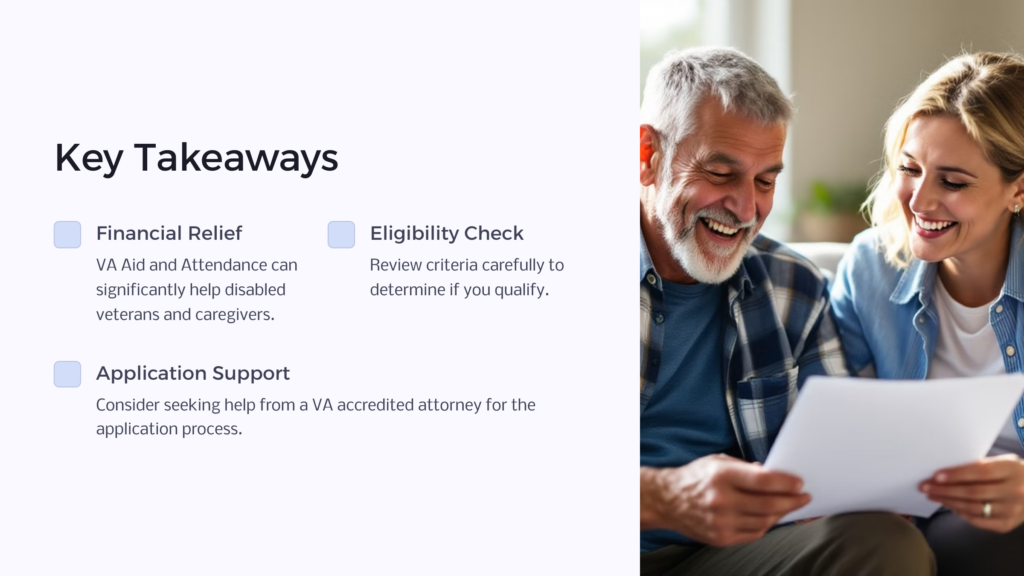VA Aid and Attendance benefits – sometimes also known as Housebound benefits – can go a long way toward easing the burden of U.S. veterans who struggle with day-to-day household tasks and self-care. If you think you might qualify, it’s good to get familiar with the specific eligibility criteria and other information about how the VA Aid and Attendance program works.
How to Qualify for VA Aid and Attendance

To qualify for VA Aid and Attendance benefits, a veteran must first receive a VA monthly retirement or VA pension benefit. Also, at least one of the following conditions must be true:
You meet age and active duty service eligibility criteria
You need help from someone else to complete normal daily living and activities
An illness or medical condition requires that you stay in bed all day
You are a patient in a long term care assisted living facility, memory care home, or nursing home
Your eyesight is limited
You suffer from an illness or permanent disability that requires you to stay home
Veterans who have trouble coping alone with day-to-day activities may be eligible to receive VA Aid and Attendance or a Housebound benefit. These VA benefits are largely intended to help cover medical expenses related to home care or residence in an assisted living or nursing facility. Being approved for VA Aid and Attendance benefits means that the VA recognizes that you either need the regular assistance of your spouse or another person or that you are unable to leave your home due to illness or disability.
Before you apply for VA Aid and Attendance, take some time to familiarize yourself with the important background information we’ve provided below – it can save you time and frustration later down the road to disability compensation.
What Is VA Aid and Attendance?
The VA Aid and Attendance program is designed to help veterans who are housebound or who otherwise struggle with the daily activities required to take care of themselves and their home. It is an additional monthly VA pension benefit paid on top of any existing VA pension for an eligible veteran and their surviving spouse, even those with a 100% veterans disability rating.
How to Qualify for VA Aid and Attendance
Let’s take a closer look at the eligibility criteria you need to meet to qualify for VA Aid and Attendance.
You Meet Age Eligibility Criteria
In most cases, a qualifying veteran must be 65 or older to be considered for VA Aid and Attendance benefits. In some exceptions, if a veteran is completely disabled, this requirement can be waived. For service criteria, you must also have a record of active duty service during wartime to be considered for VA Aid and Attendance or Housebound benefits.
You Need Help From Someone Else To Complete Normal Daily Activities
When daily living and simple tasks like bathing, dressing, and feeding yourself require assistance from someone else, you may be eligible for a VA Aid and Attendance benefit to help with long term care. The VA will want to see that without assistance from a spouse or another person, it’s impossible, or nearly so, for the veteran to remain clean and “presentable” on a daily basis.
For those with disabilities, this may include the frequent adjustment of prosthetic or orthopedic appliances that can’t be adjusted without help. It may also include help with dressing and feeding based on disabilities that result in decreased strength or coordination, especially in the upper body. This can also include any kind of physical or mental disability that may make it impossible for a veteran to protect him or herself from hazards and dangers inherent in their day-to-day environment. This includes the ability to prepare food without putting themself in danger. If a veteran can’t prepare and take all appropriate medications consistently and without reminders, that may also be a sign of eligibility for VA Aid and Attendance pension.
It’s important to note that for this requirement, your need for regular assistance does not necessarily have to show a va-service connection.

An Illness or Medical Condition Requires That You Stay in Bed All Day
If you suffer from a medical condition or illness that keeps you bedridden, it’s highly unlikely you are capable of taking care of all your necessary daily tasks. In cases like this, there’s a very good chance you would qualify for VA Aid and Attendance or Housebound benefits.
You Are a Patient in a Nursing Home
If you are a patient in a nursing home or assisted living facility because you’ve lost physical or mental abilities related to a disability, you would likely be eligible for VA Aid and Attendance or Housebound.
Your Eyesight is Limited

If you register only 5/200 or lower visual acuity even with glasses or contacts in both eyes, or if you demonstrate concentric contraction of the visual field to 5 degrees or less, you may be eligible for VA Aid and Attendance. In this case, poor eyesight can greatly hinder your ability to take care of both yourself and your home, so assistance for home care is key.
You Suffer From An Illness or Permanent Disability That Requires You to Stay Home
Those who aren’t in a position to leave their home due to illness or permanent disability may need help running basic errands, paying bills, getting groceries, etc. When this is the case, VA Aid and Attendance benefits – specifically a housebound VA benefit – can help cover the costs of this kind of help. For this requirement to be met, the qualifying veteran must already be rated 100% for a particular disability.
Who is Eligible for Aid and Attendance Benefits?
Determining eligibility is a complex process, and the ultimate decision is up to the VA. But as a general rule, veterans who qualify for VA Aid and Attendance or Housebound benefits can show proof of eligibility on three different levels – service, clinical and financial.
The first step is defining and documenting your active duty military service. The VA stipulates that if you served on active duty in the U.S. military for at least 90 consecutive days, with at least one of those days being during wartime, you can be eligible for Aid and Attendance benefits as a wartime veteran. It’s important to note that this doesn’t necessarily mean that you had to have served in a combat zone during your time of service.
Clinical eligibility criteria include those outlined above, which establish the case that you must have assistance from another person in order to safely and consistently complete day-to-day activities.
The final category of eligibility is financial – to be considered eligible for VA Aid and Attendance benefits, you must show financial need. Veterans Affairs outlines specific criteria related both to annual income and to a total net worth limit that a claimant must meet to qualify for an aid attendance benefit.
What is the Income Limit for VA Aid and Attendance?
The current countable income limit for VA Aid and Attendance is $1,644 per month or $19,736 per year. In addition to your countable income, the VA also will consider your net worth – your assets plus your income – which is capped at $129,094 up to December 1, 2020, for eligibility.
This number is a moving target, though, as it changes each year to account for inflation. For purposes of reviewing your application, the VA defines assets as any stocks, bonds, mutual funds, bank accounts, or property other than your primary residence. The VA will allow for some expenses to be deducted from your annual income before considering the final amount.
How Do I Apply for VA Aid and Attendance?
If you think you’re eligible for a VA Aid and Attendance benefit, you can apply in a few different ways. First, you can send a completed VA form – you’ll need to complete VA Form 21-2680 – to your state’s VA pension management center. You’ll need to ask your primary care physician to fill out the medical documentation section. In addition to documented medical evidence, you can also include information about your day-to-day activities and how you’re currently coping.
If you’re a resident of a nursing home, you also will need to submit a Request for Nursing Home Information in Connection with Claim for Aid and Attendance, which is VA Form 21-0779.
In addition to mailing your forms and documentation, you can also apply in person at your closest VA regional office. This may be your best option if you’re unsure of your eligibility because you can speak with a VA benefits planner. Please note that in addition to the completed application, the VA recommends including any and all appropriate medical documentation that can support your claim. This can include details about your daily life, medical records, and supporting letters from your medical team.
You also have the opportunity to submit your application online – though you shouldn’t use this option if you already receive a VA pension, you already have a pending application or you are applying to have your benefits increased.
Before you begin, it’s important to know that the application process is often long and arduous – many applicants may wait as long as 9-12 months before they start receiving any kind of benefit. To increase your chances of being approved early in the process, you can always work with a VA disability lawyer. Just know that even with a VA accredited attorney, you may not receive any benefits for at least three months.
Common Myths About VA Aid and Attendance
Before you start your application process, you should make sure you’re clear on any misconceptions or preconceived notions you may have about the program. For example, many people think that to qualify, they must require constant or continuous aid in order to complete their daily activities. This isn’t the case – the VA uses the standard “regular” aid and attendance to evaluate your eligibility. As long as you require aid and attendance on some type of regular schedule, you may qualify. You don’t necessarily have to need 24-hour, constant care. Your regular need could be as simple as someone checking in on you once a day.
However, this type of care does need to be required, which you’ll have to show within your medical documentation. Another common misconception is that just because you have a certain level of daily assistance, the VA will pay for it through your VA Aid and Attendance benefit. Just because you have regular care or would like regular care doesn’t necessarily mean it’s required. For a married veteran, for example, you must demonstrate that you can’t dress and prepare meals for yourself if your spouse isn’t there to help.
Who Qualifies As a Caregiver?
The VA does not provide specific guidelines around the definition of caregiver in a veteran household. For a married veteran, many times a spouse is the primary caregiver, but caregivers can also be other family members, friends, neighbors, or medical professionals, including skilled nursing aids and other home care workers.
VA Aid and Attendance
VA Aid and Attendance benefits can lift a tremendous financial burden from disabled veterans and their caretakers. If you think you qualify, you owe it to yourself, your spouse, and others who love you to determine if your situation warrants this extra financial veterans benefit. With the information here, you can help make an informed decision about whether to move forward with your VA Aid and Attendance benefits application.

 Benefits.com Advisors
Benefits.com Advisors
With expertise spanning local, state, and federal benefit programs, our team is dedicated to guiding individuals towards the perfect program tailored to their unique circumstances.
Rise to the top with Peak Benefits!
Join our Peak Benefits Newsletter for the latest news, resources, and offers on all things government benefits.


















